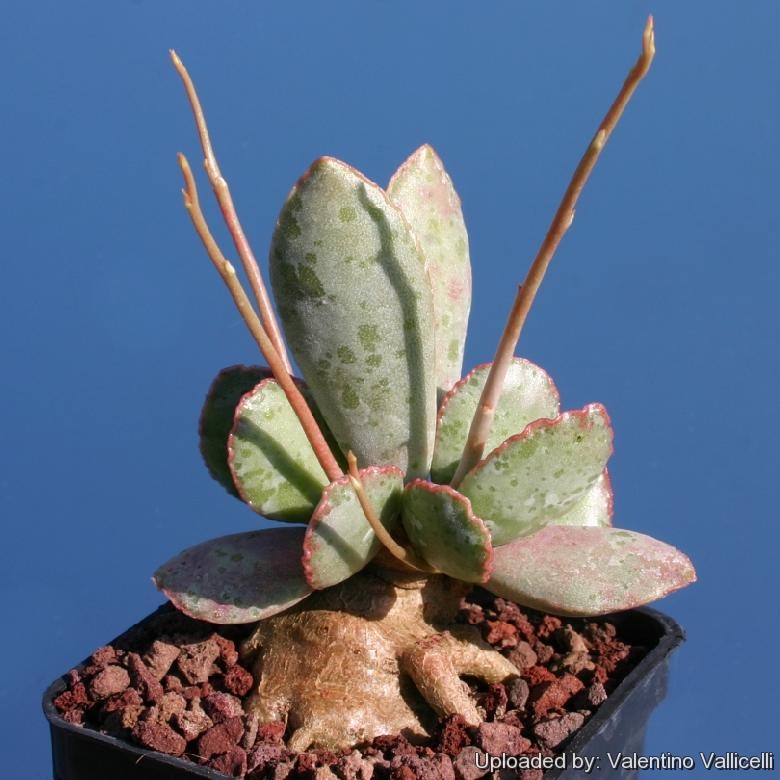
Adromischus schuldtianus
A very pretty tiny, compact, shrub, building a caudex.
Origin and Habitat: Central & SW. Namibia( & Northern Cape South Africa?). This is the most north-westerly Adromischus species. It is often found filling up cracks on granite hills usually in shady places.
Synonyms:
See all synonyms of Adromischus schuldtianus
Description: Adromischus schuldtianusSN|144]]SN|144]] is a very pretty, compact, perennials succulent shrub, building a branched tuberous base (caudex), variable in size up to 7 cm tall and 15 cm in diameter. The laeves are dusty white-green mottled with few translucent grey-green to maroon spots or unspotted and easily caducous. Three subspecies are recognized, the nominate form subs. brandbergensis and subs. juttae.
Stem: Short, erect, tapering, basally tuberose up to 4 cm or more, grey to grey green with peeling bark, distal parts 8-10 mm. Younger leave bearing branches 5-7 mm in diameter.
Rottstock (Caudex): Very thickened.
Branches: Short erect 15-30(-80) mm long.
Roots: Fibrous.
Leaves: Rounded, oblanceolate, rarely linear or obovate dorsiventrally compressed, to somewhat convex below, easily caducous up to (10-)15-20(-40) long, 2.5 cm long, (4-)6-15 mm wide (thickness 0.3-0.7 cm, dusty white-green mottled with few translucent grey-green to maroon spots or unspotted. Margin acute in upper part horny, undulating or crimped and often with a maroon- purplish tinge around at least the upper half of the leaves, upper face flat to convex. Base cuneate, more or less abruptly constricted. Apex rounded to obtuse.
Inflorescence: Spike-like thyrse with 1-flowered cymes, a 20 to 40 cm tall, grey-green to almost white; pedicels 3-5(-12) mm long. Peduncle 3-12 mm long.
Flowers: Flowers dull green to white or tinged to pink, deep mauve in the throat. Buds cylindrical and more or less grooved longitudinally, gradually tapering towards apex, erect and at first adpressed to axis. Calyx 1,5-3 mm long, grey-green. Corolla tube pale green and with thick bloom 10-13 mm long. Corolla lobes ovate-triangular, 1,5-2,5 mm long, acute to acuminate, white to pale pink and with deep mauve in throat. Anthers more or less included. Squamae square to ovate, 0,9-1,1 mm long and broad.
Subspecies, varieties, forms and cultivars of plants belonging to the Adromischus schuldtianus group
Bibliography: Major references and further lectures
1) Dr J.P. Roux “Flora of South Africa” 2003
2) John Pilbeam, Chris Rodgerson, Derek Tribble “Adromischus” Cirio Publishing Services Ltd, 1998
3) Hermann Jacobsen “Abromeitiella to Euphorbia” Blandford Press, 1960
4) Christopher Brickell "WRHS Encyclopedia of Plants and Flowers” Dorling Kindersley Ltd, 01/Sep/2010
5) Ernst Van Jaarsveld, Ben-Erik Van Wyk, Gideon Smith “Succulents of South Africa: A Guide to the Regional Diversity” Tafelberg Publishers, Limited, 01/Jul/2000
6) Hermann Jacobsen “A handbook of succulent plants: descriptions, synonyms, and cultural details for succulents other than Cactaceae” Volume 1 Blandford Press, 1960
 Adromischus schuldtianus Photo by: Valentino Vallicelli
Adromischus schuldtianus Photo by: Valentino Vallicelli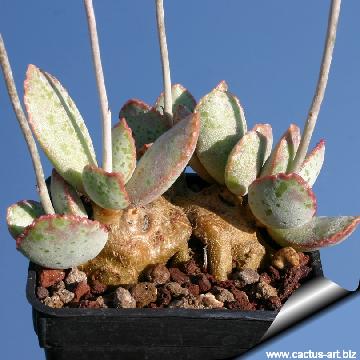 Adromischus schuldtianus Photo by: Cactus Art
Adromischus schuldtianus Photo by: Cactus Art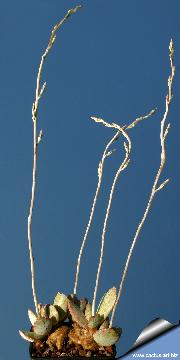 Adromischus schuldtianus Photo by: Cactus Art
Adromischus schuldtianus Photo by: Cactus Art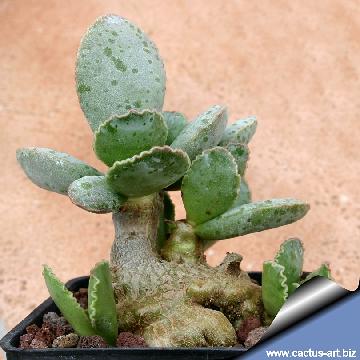 Adromischus schuldtianus Photo by: Cactus Art
Adromischus schuldtianus Photo by: Cactus Art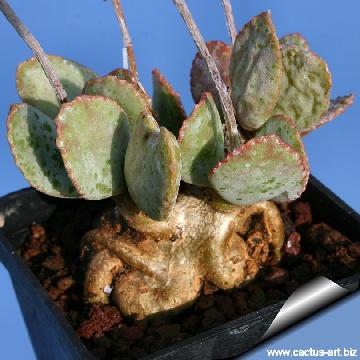 Adromischus schuldtianus Photo by: Cactus Art
Adromischus schuldtianus Photo by: Cactus Art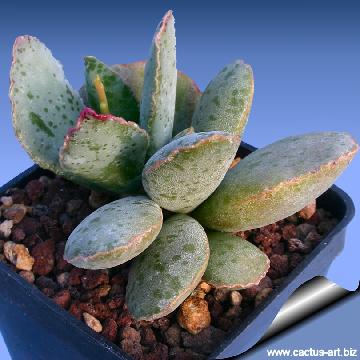 Adromischus schuldtianus Photo by: Cactus Art
Adromischus schuldtianus Photo by: Cactus Art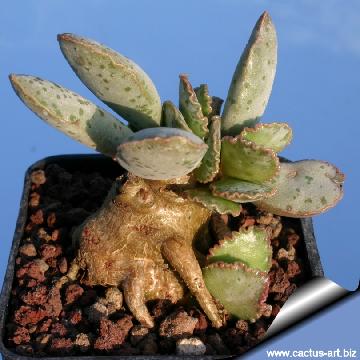 Adromischus schuldtianus Photo by: Cactus Art
Adromischus schuldtianus Photo by: Cactus Art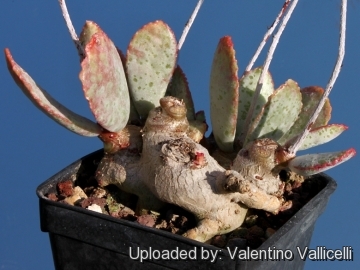 Adromischus schuldtianus Photo by: Valentino Vallicelli
Adromischus schuldtianus Photo by: Valentino VallicelliCultivation and Propagation: Adromischus schuldtianus is a most beautiful succulent but not the easiest species to cultivate, and prone to rotting off, both at the height of winter or summer.
Growth rate: It is a relatively fast growing species.
Soil: Use mineral well-permeable substratum with very little organic matter (peat, humus). It needs perfect drainage to flourish.
Repotting: Repotting every 2-3 years. As it is especially prone to rot under-pot in a smaller container filled with very porous compost. Use pot with good drainage. All species of this genus are happy in small pots.
Exposure: It grows best in a partially shaded position. It got sunburned if exposed to midday sun.
Hardiness: Require a minimum temperature 5°C (But hardy down to -7°C for short periods), with good drainage and dryness in winter to resist the cold.
Watering: It takes more water than cacti, but let the soil dry between soaking, in the wild, it receives rain mostly in spring and fall. Must have very dry atmosphere. Water less in winter but do not allow it to shrivel.
Pest & disease: It is vulnerable to mealybugs and rarely scale. It is prone to rotting from the tuberous base or from dried inflorescences. If the plants are not watered and “aired” correctly, fungicides won't help all that much.
Propagation: Adromischus seeds are very small and seed propagation is rarely used. Usually propagate from single leaves (leaf cuttings) or stem cuttings. Leaves easily root and produce new plants. Twist off a leaf and permit it to dry out a couple of days, lay it on the soil and insert the stem end partially into the soil. The original leaf should not be removed until it has dried up. Try to keep the leaf somewhat upright so that the roots are able to grow downward. If grown in a container, bottom watering by immersing the container is recommended.
Your Photos

by Cactus Art



















